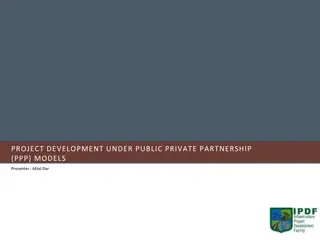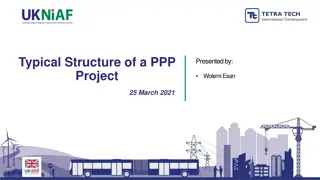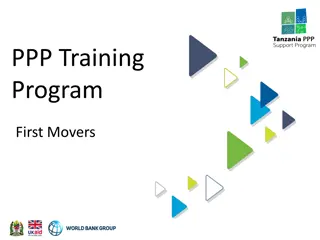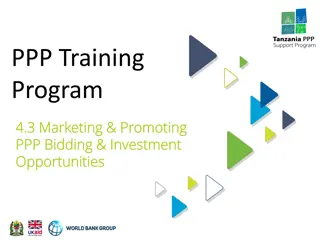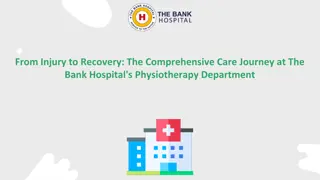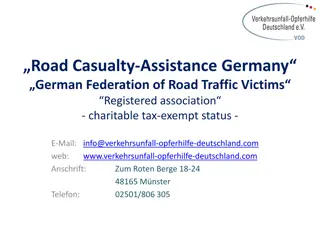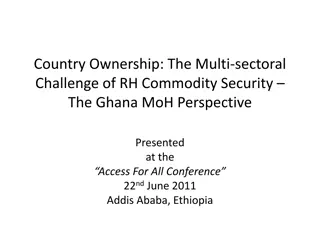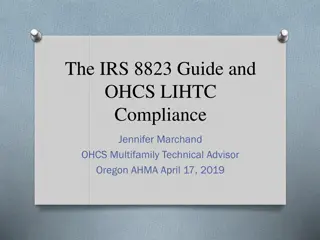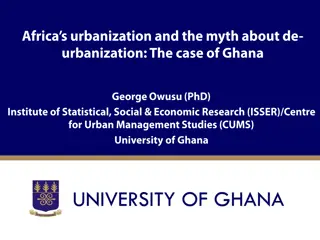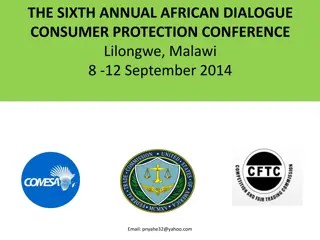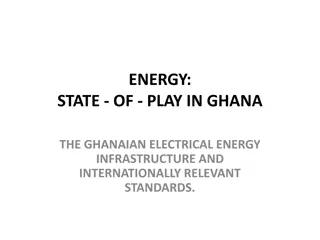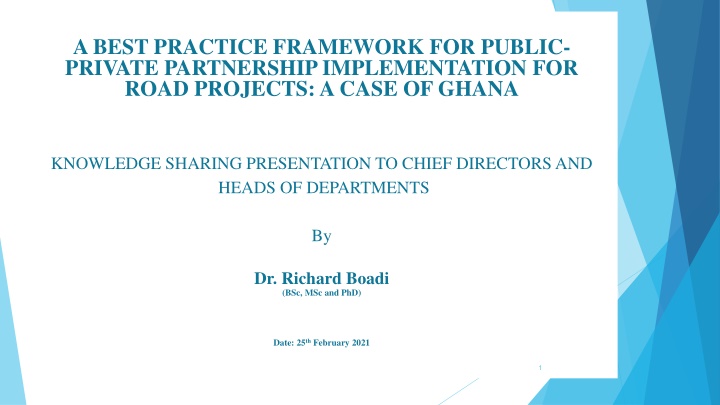
Unlocking Private Investment in Road Projects: Ghana Case Study
Explore a comprehensive research presentation on implementing public-private partnerships for road projects in Ghana, focusing on addressing infrastructure deficits and attracting private sector investment. Discover factors hindering private investment, global best practices, and strategies to create an enabling environment. Gain insights into developing a best practice framework for successful PPP road projects.
Download Presentation

Please find below an Image/Link to download the presentation.
The content on the website is provided AS IS for your information and personal use only. It may not be sold, licensed, or shared on other websites without obtaining consent from the author. If you encounter any issues during the download, it is possible that the publisher has removed the file from their server.
You are allowed to download the files provided on this website for personal or commercial use, subject to the condition that they are used lawfully. All files are the property of their respective owners.
The content on the website is provided AS IS for your information and personal use only. It may not be sold, licensed, or shared on other websites without obtaining consent from the author.
E N D
Presentation Transcript
A BEST PRACTICE FRAMEWORK FOR PUBLIC- PRIVATE PARTNERSHIP IMPLEMENTATION FOR ROAD PROJECTS: A CASE OF GHANA KNOWLEDGE SHARING PRESENTATION TO CHIEF DIRECTORS AND HEADS OF DEPARTMENTS By Dr. Richard Boadi (BSc, MSc and PhD) Date: 25thFebruary 2021 1
OUTLINE OF PRESENTATION 2. RATIONALE FOR RESEARCH 3. LITERATURE REVIEWED 4. RESEARCH QUESTIONS 1. INTRODUCTION 8. DEVELOPMENT OF BEST PRACTICE 7. RESEARCH FINDINGS 5. RESEARCH AIM AND OBJECTIVES 6. METHODOLOGY 9. STUDY IMPLICATIONS 11. RESEARCH LIMITATIONS 12. FUTURE RESEARCH 0. RECOMMENDATIONS 2
INTRODUCTION Correlation between good infrastructure and the socio-economic performance (Mua, 2016; Barrie, 2011; Cui et al., 2018). Sub-Saharan Africa (SSA) ranks at the bottom of all developing regions in all infrastructure performance (World Bank, 2018). The under-development of African s infrastructure continues to hinder its economic growth (Foster and Briceno-Garmendia, 2010). SSA needs between US$130- $170 billion yearly to fill its infrastructural Development Bank [AfDB] 2018). gap (African 3
RATIONALE FOR THE RESEARCH Ghana needs efficient infrastructure to drive the country s agenda (MoFEP 2016). industrialization Ghana s infrastructure deficit will require about $ 30 billion annually (MoFEP 2017). The approximately $ 400 million annually for 10 years (MoFEP 2017). roads sector will require The government inflows are not enough to address the infrastructure needs of the country (Teye & Asare 2014; MoFEP 2017). 4
RATIONALE FOR THE RESEARCH This deficit underscores the need for a strategic rethink financing strategies development in Ghana. of alternative for road In 2011 the Government of Ghana (GoG) launched the Ghana National Policy in 2011. Available records from World Bank (2018) indicate that some sectors in Ghana are doing well. The private sector has not shown the same interest in PPP road projects. 5
RESEARCH QUESTIONS 1. What are the factors impeding the private sector from investing in PPP road projects in Ghana? 2. What are the global best practices that can address the impeding factors identified in the study? 3. How can the factors identified from the study be addressed to create the necessary enabling environment to attract private sector investment in PPP road projects in Ghana? 6
AIM & OBJECTIVES Aim: To develop a best practice framework to address the factors impeding the private sector investment in PPP road project in Ghana by looking at global best practice. Objectives: To critically examine the existing knowledge on public-private partnerships (PPPs) to gain an understanding of PPPs, infrastructure financing, PPP project policies, and the successes or failures of PPP projects. 1) To investigate the factors preventing the private sector from investing in PPP road projects in Ghana. 2) To explore the global best practices that can address the factors identified from the study. 3) To develop and validate a best practice PPP framework that addresses the challenges identified from the study. 4) 7
SOME FINDINGS FROM REVIEWED LITERATURE 8
SOME FINDINGS FROM LITERATURE REVIEWED PRICING AND COST RECOVERY OF ROADS Ghana roads are financed through the public purse. In most cases, without any form of financial obligations from the users. The roads will require a market-based approach with fair pricing for it to be sustained and bankable. The bankability of projects is of utmost importance to the lender (Word Bank 2009). According to the World Bank, Africa has witnessed a low turnout of private sector financing in infrastructure delivery, especially roads, due to unpredictable financial return (Word Bank 2009). The private sector's main attraction to toll road investment is the ability to generate enough revenue to cover capital and recurrent costs (Robinson 2008). 9
SOME FINDINGS FROM LITERATURE REVIEWED CORRUPTION AND UNETHICAL BEHAVIOR Globally, the act of corruption is seen as a significant risk in the construction industry (Ameyaw et al., 2017). Ameyaw et al. (2015) conducted a study in the Ghanaian construction concluded that systemic corruption and unethical behaviour prevails among the public officials during the bid evaluation, tendering, and contract implementation stages. industry. They Chan and Ameyaw (2013), specifically on the challenges influencing PPP water projects in Ghana, discovered corruption as one of the significant challenges affecting Ghana's PPP implementation. 10
SOME FINDINGS FROM LITERATURE REVIEWED ORGANIZATIONAL CULTURE As mentioned in a study by Damoah and Akwei (2017), the failure of government projects in Ghana can be attributed to the poor organizational culture. That public sector workers attitude towards government work is weak, and this can be traced back to cultural orientation during the colonial period rule when public sector work was perceived to belong to the "white man 11
SOME PPP DEFINITIONS Authorities/authors Definitions of PPP The United Nations Development Programme (2008). A contractual arrangement between a public-sector agency and a for-profit private sector developer; in this arrangement, both resources and risks are shared in order to deliver a public service or the development of public infrastructure . Canadian Council for PPP, Canada (2004) A cooperative venture between the public and private sectors, built on the expertise of each partner, which best meets clearly defined public needs through the appropriate allocation of resources, risks and rewards . A long-term contract between a private party and a government entity, for providing a public asset or service, in which the private party bears significant risk and management responsibility, and remuneration is linked to performance. World Bank (2014) A generic term for the relationships formed between the private sector and public bodies, often with the aim of introducing private sector resources and/or expertise in order to help provide and deliver public sector assets and services. European Investment Bank(2010) Loosely defined PPP as cooperative institutional arrangements between public and private sector actors. Hodge and Greve (2007). defined PPP from another perspective which is structural cooperation between public and private parties to deliver some agreed outcome. Van Marrowlike et al. (2008) defined PPP as a cooperative venture between the public and private sectors for the delivery of public service through appropriate allocation of resources, risks and rewards. Akintoye et al. (2003) "long-term alliances formed between the private sector and public bodies often with the aim of exploring the private sector's resources and expertise in the provision and delivery of public services. " Chinyio and Gameson (2009) 12
SOME TERMINOLOGIES Many terms have been in used, depending on the jurisdiction (Yescombe 2007). Acronym Meaning Country PPI Private Participation in Infrastructure Private-Sector Participation Created by the World Bank and commonly used in South Korea Used in the development of the banking sector Used in North America PSP P3 Public- Private Partnership PFP Privately Financed Projects Used in Australia PFI Private Finance Initiative Originating in the United Kingdom (UK) and also being used in Japan and Malaysia The above definitions and terminologies depict the diverse interpretations of PPPs. 13
SUMMARY OF FACTORS FROM LITERATURE References 8 No Challenges 1 2 3 4 5 6 7 9 X 10 X 11 12 13 14 15 16 1 Road users not willing to pay realistic road toll 2 Public opposition to PPP road projects 3 Road users using alternative roads 4 Lack of experience and appropriate skills in the public sector 5 Political instability 6 Political interference 7 Lack of continuity of PPP road project by successive governments 8 Absence of clear institutional and PPP legal framework 9 Lack of commercially viable PPP projects to attract investors 10 Low traffic volumes 11 local banks are not capable of providing long-term finance for PPP road projects. 12 Lack of strong local capital market 13 lack of access to finance for PPP 14 Unstable macro-economic and financial conditions 15 Lack of strong PPP local market 16 Lack of transparency in the bidding process 17 Unstable macro-economic and financial conditions 18 Lack of trust in public institutions to manage PPP project 19 Lack of transparency in information disclosure 20 Excessive restrictions on participation 21 High risk relying on the private sector 22 High cost of unsolicited proposals 23 Delay due to political debate 24 Lack of PPP-enabling environment 25 Lengthy bureaucratic procedures 26 Lack of bankable projects 27 Governance and accountability weaknesses 28 High toll charges X X X X X X X X X X X X X X X X X X X X X X X X X X X X X X X X X X X X X X X X X X X X X X X X X X X X X X X X X X X X X X X X X X X X X X X X X X 14 X X X X
METHODOLOGY Type of Research Methods of Research Technique Employed The approach was first adopted to contextualise the global factors that emerged from the literature review. That led to the formation of the survey questionnaire. Qualitative Method Mixed Method 10 semi-structured interviews conducted 250 (administered through email or/and the post). Questionnaire to distributions respondents target Quantitative Method 194 were completed and returned. representing a 67.2% response rate. 15
PROFILE OF INTERVIEW PARTICIPANTS GENERAL EXPERIENCE 26 10 13 15 12 10 15 22 YEARS OF EXPERIENCE IN PPP 7 6 6 7 6 8 8 6 PARTICIPANT 'S CODE P1 P2 P3 P4 P5 P6 P7 P8 SECTOR POSITION Director Deputy Director Procurement Expert Contracts Manager Principal Engineer Project Manager Technical Adviser Chief Executive Officer Team Leader (Principal Transport Officer) Investment Banker Public Private 15 6 P9 11 7 P10 16
QUESTIONS FOR THE SEMI-STRUCTURED INTERVIEW What are the factors impeding the private sector s investments in Ghana's PPP road development? 17
FACTORS WHICH EMERGED FROM THE INTERVIEW Number of responses Total Number (N=10) Themes Factors Public Sector Private sector Total of responses Percentages of response Lack of bankable projects 4 2 6 60% Low traffic volumes 1 2 3 30% Economically PPP projects viable Lack of commercially viable PPP road projects to attract private investors 1 1 2 20% Private investors not able to recoup their investment within the concession period 3 2 5 50% Local banks inability to provide long term loans for PPP 3 3 6 60% Economic and financial conditions Lack of access to finance for PPP projects 2 3 3 50% Lack of strong local capital for PPP 0 1 1 10% Unstable economic and financial conditions 4 3 7 70% Lack of suitable skills and experience of public sector professionals in PPP 2 3 5 50% Absence of clear institutional and PPP legal framework 1 1 2 20% Policy factors and political Political instability 1 3 4 40% Successive governments not continue uncompleted PPP road projects 3 1 4 40% Lack of government support for PPP road projects 1 2 3 30% Public opposition to PPP road projects 2 1 3 30% Lack of public support for PPP road projects Road users not ready to pay realistic tolls 2 3 4 50% Road users using alternative roads rather than toll roads. 1 2 3 30% 18 Lack of transparency in the bidding process Corruption-related factors 3 4 7 70% Lack of transparency in information disclosure 1 1 2 20%
METHODOLOGY (QUANTITATIVE DATA ANALYSIS) Description analysis. The mean score and ranking of the factors was performed. A Statistical Package for Social Science (SPSS) Computer Programme Version 22.0 Kendall's Concordance Mann-Whitney U Test. 19
DEMOGRAPHIC INFORMATION RESPONDENTS Respondents organisation Respondents Sector Consultant 7%3% Contractor Public sector participants 26% Client/Employer 54% 43% Private sector participants 57% Financial and Banking Univeristy /Academia 10% RespondentsExperience Respondent Profession Construction Manager 0-5 years Construction Project Manager 5% 7% 9% 15% 4% 30% 6-10 years Quantity Surveyor 11-15 years Civil Engineer 30% 50% over 20 years Architect, Electrical Enginners, Structural Enginners and Planners 50% 20
RANKING OF FACTORS Public Sector Private Sector PPP Factors Mean 4.04 3.64 3.90 3.72 3.83 3.49 Rank 1 10 3 7 5 13 Mean 4.20 3.68 3.85 3.71 3.68 3.50 Rank 1 6 3 5 7 11 x 0.97 1.17 0.95 0.89 1.03 1.02 x 0.80 0.95 1.01 0.95 1.14 1.02 Local banks inability to provide long-term loans for PPP Lack of access to finance for PPP projects Lack of strong local capital for PPP Unstable economic and financial conditions Lack of bankable projects Low traffic volume Lack of commercially viable PPP road projects to attract private investors Private investors not able to recoup their investment within the concession period Lack of suitable skills and experience of PPP professionals Absence of clear institutional and PPP legal framework Political instability Successive governments not continue with uncompleted PPP project Lack of government support for PPP road projects Lack of transparency in the bidding process Lack of transparency in information disclosure Public opposition to PPP road projects Road users not ready to pay realistic tolls Road users using alternative roads 3.50 1.27 12 3.46 1.25 14 4.00 0.87 2 3.56 1.13 10 3.44 3.68 3.64 1.2 1.09 0.98 16 8 9 3.18 3.72 3.61 1.26 0.86 0.99 17 4 9 3.88 1.07 4 3.97 0.96 2 3.29 3.44 3.56 2.76 3.83 3.47 1.25 1.2 0.99 1.08 1.03 1.13 17 15 11 18 6 14 3.26 3.36 3.48 2.67 3.68 3.50 1.15 1.08 1.13 1.03 1.14 1.20 16 15 13 18 8 12 21
BEST PRACTICE FACTORS FROM THE STUDY Proposed best practice factors Prepare a bankable PPP road project Increase the commercial activities along the road the corridor Government to provide viability gap funding (VGF). Banking sector reform Government to give financial backing to the private sector Develop the local capital market Government to provide support for private investors in the form of guarantees. Train and retain skilled and knowledgeable public officials. Government to provide a favourable legal and institutional framework for PPPs Government to ensure political stability Consultation and engagement of opposition political parties. The PPP framework including a policy on stake-holders engagement Government to provide support for PPPs by creating an enabling environment. Government engaging all stakeholder for their support and commitment Road tolls should be affordable for road users. Government to subsidise where possible Alternative routes should not be created on the same corridor. Prospective alternative roads should be made known to the bidders. Ensure fair and competitive transparent procurement process by following procurement protocols. Information disclosure framework should be provided that incorporates appropriate information disclosure provisions. 22
BEST PRACTICE FRAMEWORK DEVELOPMENT & VALIDATED The development of the framework took into consideration the PPP project life cycle approach. The method is a time tested method which has been used by earlier researchers like Osei-Kyei and Chan (2018a); Kavishe et al. (2018) and Cheung (2009). 23
GHANA PPP PROCUREMENT CYCLE OPERATIONS, MAINTENANCE AND TRANSFER PROJECT INCEPTION PROCUREMENT CONSTRUCTION MANAGEMENT Project solicitation process Market sounding Request for expression of interest (EOI) and evaluation Request for proposal (RFP) and evaluation Due Diligence Negotiations Contract Award Financial closure Contract execution Monitor the implementation of PPP agreement and ensure all parties to the contract comply with their obligation. Ensure the outputs of the project are obtained. Ensure objectives of the PPP arrangements are met. Generally implementation agreement. Prepare periodic reports on the implementation of the PPP project for stakeholders. Submit Annual report Project identification Project registration Project note Prefeasibility study Feasibility study Manage claims and disputes Monitor performance changes, inception oversee of the PPP the 24
FRAMEWORK VALIDATION Criteria Selection of Participants Participant's information Validation Results First, the participants needed to have more than 5 years of experience/knowledge in PPP projects. Position Sector Exp. Project Manager Contract Manager Deputy Director Procurement Specialist Public Director Senior Project Manager Private Senior Procurement Procurement Expert Principal Consultant Public Public Public 7 years 8 years 6 years 10 years 8 years 7 years 10 years 12 years 9 years Respondent and Response Aspects of Validated Mean R 1 R 2 R 3 R 4 R 5 R 6 R 7 R 8 R 9 Finally, the participants needed to have sufficient knowledge about road projects in Ghana. Relevance of the impeding factors 4 5 5 4 5 5 3 4 4 4.33 Public Usefulness of the best practice from study 4 4 4 5 4 4 5 3 5 4.22 Comprehensiveness of the proposed solution 4 2 5 4 4 5 4 3 4 3.89 . Private Private Private Appropriateness of the impeding factors and the best practices within each PPP process cycle 5 4 4 4 4 5 3 4 3 4 The extent to which the best practice framework, if implemented, could help in attracting private sector investments in PPP road projects in Ghana 4 4 4 5 4 5 4 4 3 4.11 25
VALIDATED BEST PRACTICE FOR PPP INCEPTION PHASE 26
BEST PRACTICE FOR PPP PROCUREMENT PHASE 28
Recommended solutions/Actions ( For Government) Guidance for private investors to manage investment risk Specific action, short term at the project level Challenges Best Practice Rationale Long-term at the policy level Viability of user-pays PPP road project depends on payment of realistic road tolls. Therefore, the government may grant a concession to a private investor to charge road users for using the road at the operation stage. In a situation where willingness to pay a realistic road toll is a problem for the road users, the government may offer support by filling in the gap by providing Viability Gap Funding (VGF) to keep the price of the toll charges to a level socially and politically acceptable for the population. The government should provide subsidies to support PPP road projects where users are not able to pay a realistic road toll. The PPP framework should provide clear rules for accounting for government fiscal commitment . Government can also set up a Viability Gap Fund to support PPP road project The false expectation of user willingness to pay may lead to an underutilised and financial problem when Authority should only tender out and enter into PPP contract when affordability government and perspective), and willingness test has been satisfactorily. The willingness of road users to pay realistic toll could impact on the commercial viability of PPP road project. Therefore, the private investors should ensure availability to pay realistic toll is tested during project appraisal phase or VGF provision is made during the contract structuring phase. Text for individual affordability willingness to pay realistic during preparation phase Road users not willing to realistic road tolls and completed. pay tolls the reporting and (from individual passed Traffic volume is a crucial input into the financial and economic viability and sustainability of toll road projects. Hence, road users using an alternative road could reduce the traffic volume and, consequently, affect the revenue streams. However, the road is public infrastructure, and therefore there must be an alternative road for those who are financially challenged. The structure of the toll charges has implications on investor s income stream. Thus, the private investor should ensure the impact of all alternative roads and future roads are assessed and appropriate risk mitigation detailed in the contract. The decision to allow a free alternative route shall only be made after sound economic analysis has been conducted. Alternative roads should not be provided along the same PPP toll road. the private Road users using alternative roads Assess the impact of alternative road on PPP projects Government alternative free roads should be made available to road users along the toll road corridor. should decide if road Assess staffing capabilities and needs. Select requisite experience knowledge to manage PPP implementation. Attract and retain the right talent to a public sector to allow for a common baseline for PPP knowledge and best practices. Many PPP project failures have been as a result of poor assessment, and preparation (appraisal) of the project, poor structuring and poor management of the tender process. For this reason, experienced advisors are highly recommended for appraising, preparing, structuring, and supporting the tender process. firms with and identification, Lack adequate PPP and expertise of The PPP legal framework should include a policy on how to assess staffing capabilities needs and hiring of experts. The government should resource the PPP unit and develop a policy to retain the public officials The private investor should ensure that the PPP procuring authority has adequate expertise to manage the PPP implementation. skills Attract and retain the right talent experience or 29
Recommended solutions/Actions ( For Government) Long-term at the policy level Specific action, short term at the project level Best Practice Guidance for private investors to manage investment risk. Challenges Rationale Concession periods for PPP road projects usually far exceed the term of a government. After a change in government, the new administration may not have an interest in the project of their predecessors and may revoke the concession agreement. Private investors need to have faith in the continuation of the original concession agreement after any change in government. The government should build a political consensus on the use of the PPP model. Ensure national consensus on the eligible roads for PPP projects. The PPP framework should provide the private investor with significant protection in the case of unilateral termination Follow the agreed PPP model and select road projects from the list of eligible roads. Ensure there is a political acceptance of the selected road projects. The contract should define and grant the private partner the right compensated in full in the event of unilateral termination The private investor should ensure that the issue of government abandoning or terminating PPP project is considered as a risk and allocate it to the party able to manage it during the contract structuring phase. Successive government a bandoning PP P Project Engage opposition political parties. to be Private investors respond favourably to a simple and clear institutional and legal framework, where processes and procedures on how to engage with the public sector are spelt out. Establishing a clear PPP framework public communicates the government s commitment to PPPs Therefore, to attract private sector financing for PPP road projects, the government must develop a sound institutional and legal framework that set out rules, mechanisms, and procedures on how to govern the PPP implementation. The government should provide good and favourable institutional and framework Government favourable legal framework for PPP to guide government and private partners through each step in developing and implementing a PPP project. to provide and The framework should protect the private investors investment and interest. Issues that are pertinent to the private investor which are not addressed in the framework should be discussed during the negotiation/dialogue phase. PPP legal and institutional institutional Lack of clear institutional and PPP legal framework Implement PPP road projects in line with the institutional and legal framework a legal The government should develop a policy for the utilisation of space/sites along the proposed PPP road corridor to build sectors that are sensitive to economic activities to generate third-party revenues or allow the private sector to develop collateral businesses Model traffic on complex road networks and impact on the viability of the PPP road project, alternative routes exist. Conduct detailed revenue studies demand and demand elasticity. Ensure traffic volume supports PPP projects The volume of traffic is critical to the sustainability of PPP road toll projects. Hence, tolled road traffic demand forecasting is a crucial input in the financial and economic appraisal of toll road projects. understand its Traffic risk could have an adverse effect on a PPP road project. Therefore, the private investor should ensure that the government provides a guarantee for when traffic volume is below the baseline volume. Low volume traffic mainly when road traffic to and 30 estimate
Guidance investors investment risk. for to private manage Recommended solutions/Actions ( For Government) Long-term policy level at the Specific action, short term at the project level Best Practice Challenges Rationale The government should build a political consensus on the use of the PPP model. Ensure national consensus on the eligible roads for PPP projects. The PPP framework should provide the private investor with significant protection in the case of unilateral termination Concession periods for PPP road projects usually far exceed the term of a government. After government, the new administration may not have an interest in the project of their predecessors and concession agreement. Private investors need to have faith in the continuation of the original concession agreement after any change in government. Follow the agreed PPP model and select road projects from the list of eligible roads. Ensure there is a political acceptance of the selected road projects. The contract should define and grant the private partner the right to be compensated in full in the event of unilateral termination. The private investor should ensure that the issue of government abandoning or terminating PPP project is considered as a risk and allocate it to the party able to manage it during the contract structuring phase. a change in Successive government abandoning Project Engage opposition political parties may revoke the There could be a high possibility of opposing the PPP project when they are not well engaged during the identification and appraisal phase. Therefore, the private investor should treat it as a possible risk. PPPs involve various stakeholders with different interests. Thus, the attitude of each stakeholder could influence the output of a PPP road project. Therefore, the commitment of all stakeholders should be sought during implementation. the public Identify key stakeholders and develop a communication plan and describe strategy to be adopted in communicating stakeholders. The should include a policy on stakeholders engagement and management PPP framework Engage stakeholders and address their concerns the project key Public opposition to PPP road projects the general project to the the project No international, investing in a country which is not politically stable. Political instability has led to the failure of some initiated PPP projects in some developing countries and may have deterred investing in future PPP projects. However, a stable political environment attracts adequate private sector investors to invest in the roads sector. investor, whether will local comfortable or Political instability has harmed many countries performance. Therefore, the risk is very high to invest in a country where there is no political stability. A private investor should be careful to invest in a country where there is not assured stability. be Ensure political stability during and after general elections is Also, the PPP framework should include a policy on how to protect the private sector investment in case of political instability economic observed. Engage the various political parties and obtain consensus across the political divide. Ensure environment a stable political Political instability investors from political 32
PRACTICE FOR PPP OPERATION, MAINTENANCE, AND TRANSFER PHASE 33
Recommended solutions/Actions ( For Government) Guidance for private investors to manage investment risk. Best Practice Rationale Specific action, short term at the project level Challenges Long-term at the policy level Follow the agreed PPP model and select road projects from the list of eligible roads. Ensure there is a political acceptance of the selected road projects. The contract should define and grant the private partner the right to be compensated in full in the event of unilateral termination Concession periods for PPP road projects usually far exceed the term of a government. After government, the new administration may not have an interest in the project of their predecessors and concession agreement. Private investors need to have faith in the continuation of the original concession agreement after any change in government. The should ensure that the issue of abandoning terminating PPP project is considered as a risk and allocate it to the party able to manage it during the structuring phase private investor The government should build a political consensus on the use of the PPP model. Ensure national consensus on the eligible roads for PPP projects. The PPP framework should provide the private investor with significant protection in the case of unilateral termination of PPP road project. a change in government Successive government not continue with PPP Project or Engage opposition political parties may revoke the contract There could be a high possibility of the public opposing project when they are not well engaged during the project identification and appraisal Therefore, the private investor should treat it as a possible risk. PPPs involve various stakeholders with different interests. Thus, the attitude of each stakeholder could influence the output of a PPP road project. Therefore, the buy-in of all stakeholders should be sought during the project implementation. Identify key stakeholders and develop a communication plan and describe the strategy to be adopted in communicating stakeholders. the PPP Engage project stakeholders and their concerns the key Public opposition to PPP projects The PPP framework should include a policy on engagement and management general road stakeholders address to the phase. The structure of the toll charges has implications on the private investor s income stream. Thus, the private should ensure the impact of all alternative roads are assessed appropriate mitigation detailed in the contract. Traffic volume is a crucial input into the financial and economic viability and sustainability of toll road projects. Hence, road users using an alternative road could reduce the traffic consequently, affect the revenue streams. However, the road is public infrastructure, and therefore there must be an alternative road for those who are financially challenged. The decision to allow a free alternative route shall only be made after sound economic analysis has been conducted. The alternative road should not be provided along the same PPP toll road. 34 Assess the The government should decide if alternative free roads should be made available to road users along the toll road corridor. impact of the investor Road users using volume and, alternative road alternative roads on PPP road and risk project
PRACTICAL IMPLICATION OF THE STUDY This government and policymakers about issues to be addressed at every stage of the PPP project cycle in order to create the necessary enabling environment that will incentivise the private sector to invest in PPP road projects. framework will inform the The framework proposes tailor-made solutions to address the identified challenges pertaining to the country. Therefore, the solution will also act as a blueprint for PPP road projects in other countries with similar conditions. 35
RESEARCH LIMITATIONS PPP practice in the Ghanaian road sector is relatively new. Therefore, the factors could not be tested on an ongoing PPP road project. However, a rigorous scientific method was employed in reaching the outcome of this study 36
FUTURE STUDY Further research could test the framework on ongoing PPP road projects. Applicability of the availability and shadow payment model, which is principally used in the UK. Long-term funds, like the pension funds for PPP road projects. 37
CONCLUSION It is widely accepted that an enabling environment would crowd the private sector to invest in PPP road project. Despite acceptance of PPPs in Ghana the private sector has not shown any interest in PPP road project. the introduction and We have looked at the factors that prevent the private sector from investing in PPP road projects in Ghana. A framework on how to address the factors preventing the private sector from investing in PPP road projects in Ghana as been explored. 38



